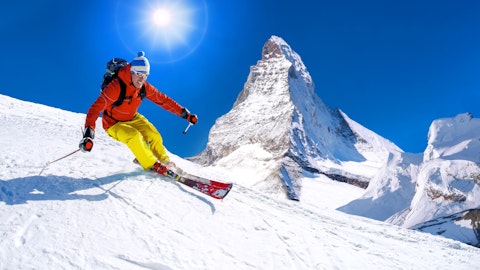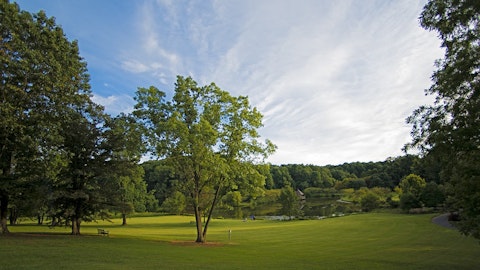Vail Resorts, Inc. (NYSE:MTN) Q2 2023 Earnings Call Transcript March 9, 2023
Operator: Good afternoon, and welcome to the Vail Resorts Fiscal 2023 Second Quarter Earnings Call. Today’s conference is being recorded. Currently, all callers have been placed in a listen-only mode and following management’s prepared remarks, the call will be opened up for your questions. I will now turn the call over to Kirsten Lynch, Chief Executive Officer of Vail Resorts. You may begin.
Kirsten Lynch: Thank you. Good afternoon, everyone. Welcome to our fiscal 2023 second quarter earnings conference call. I am pleased to have Angela Korch, joining me on the call today, who recently rejoined Vail Resorts as Chief Financial Officer. Before we begin, let me remind you that some information provided during this call may include forward-looking statements that are based on certain assumptions and are subject to a number of risks and uncertainties as described in our SEC filings and actual future results may vary materially. Forward-looking statements in our press release issued this afternoon, along with our remarks on this call are made as of today, March 9, 2023, and we undertake no duty to update them as actual events unfold.
Today’s remarks also include certain non-GAAP financial measures. Reconciliations of these measures are provided in the tables included with our press release, which along with our quarterly report on Form 10-Q were filed this afternoon with the SEC and are also available on the Investor Relations section of our website at www.vailresorts.com. So with that said, let’s turn to our fiscal 2023 second quarter results. Overall, we are pleased with the strong guest experience being delivered at our resorts, supported by the investments we made in our resorts and in our employees, which enabled greatly improved staffing levels and employee satisfaction scores, a return to normal operations and strong guest satisfaction scores. Our ancillary businesses, including ski school, dining, and rental and retail, experienced strong growth compared to the prior year period, when staffing shortages constrained capacity of ancillary businesses.
We believe these investments in staffing and our commitment to enhancing the guest experience establish a strong foundation for future growth. Improved conditions at our Colorado, Utah and Tahoe resorts enabled select early resort openings and drove strong early season local visitation, and the easing of travel restrictions in Canada contributed to a strong rebound in destination visitation at Whistler Blackcomb relative to the prior year period. As discussed in our January metrics release, visitation at our western U.S. resorts was negatively impacted by airline travel disruptions during the peak holiday period, as well as severe weather disruptions at our Tahoe resorts. In Tahoe, significant snowstorms continued to impact resort access and limit our ability to fully open our resorts throughout the remainder of the quarter.
Across our 26 Midwest, Mid-Atlantic and Northeast resorts, collectively referred to as our Eastern U.S. resorts, results for the quarter were negatively impacted by abnormal weather conditions, which significantly reduced operating days, terrain availability and activity offerings across the region which impacted demand and increased operating costs, including snowmaking, grooming and related labor costs. In particular, results at our Eastern U.S. resorts were significantly below expectations in the post-holiday period, as conditions did not return to normal after the holidays as was incorporated in our guidance, with January having only 50% to 60% of lifts and terrain open during that period. Compared to the second quarter of fiscal 2022, resort net revenue increased approximately 21% and we achieved record second quarter visitation and resort net revenue as our ancillary lines of business continued to significantly outperform the prior year.
The recent significant investment in our employees helped drive increased staffing levels relative to the prior year, enabling our mountain resorts to deliver normal operations of important guest experiences such as our restaurants, lodging, ski and ride school, and rental and retail locations, which helped drive a return of ancillary spending. Dining revenue rebounded strongly from the prior year period, though underperformed expectations for the quarter as guest dining behavior has not fully returned to pre-COVID-19 levels following two years of significant operational restrictions associated with COVID-19. Resort reported EBITDA decreased approximately 1% from the prior year, as profitability was impacted by the investment in our employee and guest experience, early openings and expanded terrain at our Western resorts, as well as increased operating costs from the abnormal weather conditions at our Eastern U.S. resorts.
We achieved normalized staffing levels this season to ensure we are delivering a strong guest experience, and we are pleased with the significant improvement in guest satisfaction scores, which have exceeded pre-COVID-19 levels at our destination resorts. Now I would like to turn the call over to Angela to further discuss our financial results, season-to-date metrics and fiscal 2023 outlook.
Angela Korch: Thanks, Kirsten, and good afternoon, everyone. It is great to be back with Vail Resorts and to be speaking with you today. For the second quarter of fiscal 2023, net income attributable to Vail Resorts was $208.7 million, or $5.16 per diluted share, compared to the prior year of $223.4 million, or $5.47 per diluted share. Resort reported EBITDA was $394.8 million in the second fiscal quarter, which compares to resort reported EBITDA of $397.9 million in the same period in the prior year. Turning to our season-to-date metrics. For the period from the beginning of the ski season through Sunday, March 5, 2023 compared to the prior year period through March 6, 2022. The reported ski season metrics are for the company’s North American destination mountain resorts and regional ski areas, including the results of Seven Springs, Hidden Valley and Laurel Mountain in both periods and excluding the results of the Australian ski areas and Andermatt-Sedrun in both periods.
The data mentioned in this release is interim period data and is subject to fiscal quarter end review and adjustments. We are pleased with the continued growth in visitation and ancillary revenue growth throughout the season. Season-to-date, total skier visits were up 3.6% compared to the fiscal year 2022 season-to-date period. Season-to-date total lift ticket revenue, including an allocated portion of our season pass revenue for each applicable period, was up 2.5% compared to the fiscal year 2022 season-to-date period. For our ancillary results season-to-date ski school revenue was up 27.6%. Dining revenue was up 37.2%. And retail and rental for North American resort and ski area store locations was up 21.2% compared to the prior year period.
Season-to-date results at our Eastern U.S. resorts continued to be negatively impacted by periods of both unseasonably warm and extreme cold weather, which disrupted operating days, impacted demand, and increased operating costs. Across our Eastern U.S. resorts, over 25% of planned operating days for the 2022/2023 ski season were negatively impacted by extreme weather events, including many days with full or partial resort closures. At our Tahoe resorts, significant snowstorms continued to impact resort access and limited our ability to fully open our resorts. In the Rockies, destination visitation has continued to improve relative to expectations as the season has progressed past the peak holiday period. Whistler Blackcomb continues to see a strong rebound in destination visitation, including international, relative to the prior year period driven by the easing of travel restrictions in Canada.
Our ancillary businesses continued to see strong growth over the prior year period, driven by increased staffing levels that enabled our mountain resorts to deliver normal operations of important guest experiences such as our restaurants, lodging, ski and ride school, and rental and retail locations, which helped drive a return of ancillary spending. Now turning to our outlook for fiscal 2023. While we continue to expect strong demand from our destination guests at our western North American resorts for the remainder of the season, we are lowering our guidance for fiscal 2023, primarily due to the significant weather disruptions at our Eastern U.S. resorts throughout the season-to-date period, as well as continued significant snowstorm disruptions at our Tahoe resorts.
For fiscal 2023, we expect contribution margin from our 26 Eastern U.S. resorts, excluding an allocated portion of pass product revenue, to underperform initial expectations provided in September 2022 by approximately $43 million, with the majority of the underperformance occurring after the peak holiday period. The weather disruptions in the East and in Tahoe impacted both operating days and visitation and also increased operating costs. Our Eastern U.S. resorts have a significantly lower proportion of skier visits in advance commitment products relative to our western destination resorts, and the financial results this year further strengthen our resolve to continue to drive guests into an advance commitment product, particularly in our northeast markets.
While we are disappointed to be lowering guidance for the fiscal year, we know that the financial impact to the company of weather and travel disruptions was greatly mitigated by our advance commitment products, which provide an incredible value to the consumer and much greater stability to our company and our communities. We now expect net income attributable to Vail Resorts for fiscal 2023 to be between $282 million and $328 million, and resort reported EBITDA for fiscal 2023 to be between $831 million and $859 million. We estimate resort EBITDA margin for fiscal 2023 to be approximately 29.4%, using the midpoint of the guidance range. The updated outlook for fiscal year 2023 assumes a continuation of the current economic environment, normal weather conditions, and no material impacts associated with COVID-19 for the remainder of the 2022/2023 North American and European ski season or the 2023 Australian ski season.
It is important to note that there continues to be uncertainty around the economic outlook and the impact that may have on travel and consumer behavior. The guidance assumes current exchange rates as outlined in our earnings release. Relative to our original September 2022 guidance, we estimate the movements in exchange rates will result in a fiscal 2023 guidance impact of approximately negative $6 million for resort reported EBITDA. Our balance sheet remains strong. Our total cash and revolver availability as of January 31, 2023 was approximately $1.9 billion, with $1.3 billion of cash on hand, $415 million of U.S. revolver availability and $212 million of revolver availability under our Canadian facility. As of January 31, 2023, our net debt was 1.9x trailing 12 months total reported EBITDA.
We remain confident in the strong free cash flow generation and stability of the underlying business model. Given these dynamics, we are pleased to announce that our Board of Directors declared a quarterly cash dividend on Vail Resorts’ common stock of $2.06 per share, representing an 8% increase in our quarterly dividend. The dividend will be payable on April 11, 2023 to shareholders of record as of March 27, 2023. Additionally, our Board of Directors has increased our authorization for share repurchases by 2.5 million shares to approximately 3.5 million shares, and we intend to be aggressive in returning capital to shareholders while always focusing on the long-term value of our shares. We will continue to be disciplined stewards of our capital and remain committed to prioritizing investments in our guest and employee experience, high-return capacity expanding capital projects, strategic acquisition opportunities and returning capital to our shareholders through our quarterly dividend and share repurchase programs.
Now I’ll turn the call back over to Kirsten.
Kirsten Lynch: Thank you, Angela. We remain dedicated to delivering an exceptional guest experience and will continue to prioritize reinvesting in the experience at our resorts, including consistently increasing capacity through lift, terrain and food and beverage expansion projects. As previously announced, the company expects to invest approximately $180 million to $185 million, excluding one-time investments related to integration activities, deferred capital associated with the Keystone and Park City projects, $5 million of reimbursable investments associated with insurance recoveries, and $10 million of growth capital investments at Andermatt-Sedrun. At Keystone, we received U.S. Forest Service approvals and plan to complete the transformational lift-served terrain expansion project in Bergman Bowl, increasing lift-served terrain by 555 acres with the addition of a new six-person high speed lift.
At Breckenridge, we plan to upgrade the Peak 8 base area to enhance the beginner and children’s experience and increase uphill capacity from this popular base area. The investment plan includes a new four-person high speed 5-Chair to replace the existing two-person fixed-grip lift as well as significant improvements, including new teaching terrain and a transport carpet from the base, to make the beginner experience more accessible. At Stevens Pass, we are planning to replace the two-person fixed-grip Kehr’s Chair lift with a new four-person lift, which is designed to improve out-of-base capacity and guest experience. At Attitash, we plan to replace the three-person fixed-grip Summit Triple lift with a new four-person high speed lift to increase uphill capacity and reduce guests’ time on the longest lift at the resort.
These projects are subject to regulatory approvals and are currently planned to be completed in time for the 2023/2024 North American winter season. Additionally, the company plans to expand parking by more than 500 spaces across Heavenly, Mount Sunapee, Liberty and Roundtop to improve the guest experience. At Whistler Blackcomb, subject to final permitting, we plan to replace the four-person high speed Fitzsimmons lift with a new eight-person high speed lift in calendar year 2023. We now plan to replace the four-person high speed Jersey Cream lift with a new six-person high speed lift in calendar year 2024, given Doppelmayr Canada has informed Vail Resorts that they cannot install both lifts this summer due to their labor and resource constraints.

Kaspars Grinvalds/Shutterstock.com
The company is planning to accelerate certain investments in our gear rental business to enhance the experience for guests into calendar year 2023, which will offset the deferred costs related to the Jersey Cream lift installation. The company is planning to introduce new technology for the 2023/2024 ski season at its U.S. resorts that will allow guests to store their pass product or lift ticket directly on their phone and scan at lifts hands-free, eliminating the need for carrying plastic cards, visiting the ticket window or waiting to receive a pass or lift ticket in the mail. Once loaded on their phones, guests can store their phone in their pocket, and get scanned hands free in the lift line using Bluetooth Low Energy technology. In addition to the significant enhancement of the guest experience, this technology will also ultimately reduce waste of printing plastic cards for pass products and lift tickets, and RFID chips, as a part of the company’s commitment to zero.
For the first year of launch, to ensure a smooth transition, the company will provide plastic cards to all guests, and in future years plastic cards will be available to any guests who cannot or do not want to use their phone to store their pass product or lift ticket. We are also excited to announce the launch of our new My Epic app, which will accompany our Mobile Pass technology and will include interactive trail maps, real-time and predictive lift line wait times, personalized stats, and other relevant information to support the guest experience. The company is also investing in network-wide scalable technology that will enhance our analytics, e-commerce and guest engagement tools to improve our ability to target our guest outreach, personalize messages and improve conversion.
In addition to these investments, we are planning to invest approximately $10 million at Andermatt-Sedrun in high-impact growth capital projects as an initial step in a multi-year strategic growth investment plan to enhance the guest experience on the mountain, which will be funded by the CHF110 million capital that was invested as part of the purchase of our majority stake in Andermatt-Sedrun. As part of the calendar year 2023 investments, we are planning to upgrade and expand Sedrun’s snowmaking to enhance the guest experience. In addition, we plan to enhance the on-mountain dining experience with renovations to the Milez and Natschen restaurants and replacement of the Valtgeva restaurant. These investments are expected to be completed ahead of the 2023/2024 European ski season and remain subject to regulatory approvals.
Including $1 million of one-time investments related to integration activities, $10 million of deferred capital associated with the Keystone and Park City projects, $5 million of reimbursable investments associated with insurance recoveries, and $10 million of growth capital investments at Andermatt-Sedrun, our total capital plan for calendar year 2023 is expected to be approximately $206 million to $211 million. Turning to pass sales. We are excited to launch pass sales for the 2023/2024 season with a wide range of advance commitment products including our Epic Day Pass, which provides one to seven days of access at our owned and operated resorts, and our unlimited Epic Pass products, which can provide unlimited access to 41 resorts every day of the season and additional access to partner resorts, with no reservations required at any resort except Telluride.
For the 2023/2024 European ski season, we are excited to add Disentis as a long-term partner resort, providing pass holders access to the largest ski area in the heart of Switzerland spanning across Andermatt-Sedrun and Disentis. We are pleased to welcome our pass holders back to the program as we roll out new technology and infrastructure upgrades next season, and we look forward to welcoming more guests to the benefits of our advance commitment program. On average, our pass prices have increased 8% over the prior season’s launch price and continue to represent a strong value to our guests. In closing, I would like to thank all of our employees especially our frontline team for their passion, hard work and commitment to creating an experience of a lifetime for our guests.
And I particularly want to thank all of our employees in the Tahoe region. A state of emergency has been declared for the Tahoe region as a result of the expected upcoming storms and the safety of our employees and our guests continues to be a top priority. The guest experience that our employees create is our mission as a company and lies at the center of our success. We all look forward to welcoming guests to our mountain resorts this spring. At this time, Angela and I will be happy to answer your questions. Operator, we are now ready for questions.
See also 12 Fastest Growing Countries in Latin America and 10 High Growth Chinese Stocks.
Q&A Session
Follow Vail Resorts Inc (NYSE:MTN)
Follow Vail Resorts Inc (NYSE:MTN)
Operator: We’ll take our first question from Shaun Kelley of Bank of America.
Shaun Kelley: Hi. Good afternoon, everyone. Hi, Kirsten and Angela.
Kirsten Lynch: Hi, Shaun.
Shaun Kelley: Just maybe to lead off here, obviously it was a pretty challenging operating environment. So two areas that I’d love to just hit on briefly. One, would be could you quantify some of the disruption in Lake Tahoe? It seems like you were able or willing to do that in the northeast, but Tahoe, we’ve all read and seen the headlines. The environment there is pretty dramatic. Is that not material? Or is there a reason maybe because it’s ongoing that we haven’t? And then secondarily, Kirsten, if you could just comment. There was a change on the executive front as it relates to the operations. Could you just comment a little bit on that and sort of what’s being done to maybe adjust the organization to some of the volume levels that we’re seeing in the business right now?
Kirsten Lynch: Thanks, Shaun. Appreciate your comments. There are a lot of things that we are very pleased about from this season and as you noted, a challenging operating environment and we are incredibly disappointed by the limits to our operations in the east region as well as in the Tahoe area as well. We quantified the east region in particular because of how significant it is that there are 26 resorts in that region, that we the majority of the impacts occurred after the peak holiday season and we had expected it to improve and instead it actually got worse. The Tahoe storms and impacts of those storms are factored into our guidance and we believe once we get through that cycle, set us up to have a strong spring in Tahoe. As it relates to the operations and can you repeat your second question, Shaun, just to make sure
Shaun Kelley: Yes. I mean, I believe the Chief Operating Officer was changed. Bill Rock was obviously promoted up there. Maybe what prompted that change and what will be some of the priorities on the operating front just maybe as we kind of adjust to what the volumes are in the business right now?
Kirsten Lynch: Yes. So regarding the President of the Mountain Division, this decision to me is about the right leadership for the future of the Mountain Division. We are incredibly grateful for James and his contributions over the many years he’s been with the company, he’s had a significant impact across many different businesses, including developing leaders and Bill Rock is the right leader for the future of the Mountain Division and to take that division into the future. Bill brings almost three decades of experience in the industry, incredible expertise and experience and mountain operations and is an incredibly strong leader. So we are very excited to have Bill move into that role effective May 1.
Shaun Kelley: Thank you very much.
Kirsten Lynch: Thanks, Shaun.
Operator: Our next question is from Ben Chaiken of Credit Suisse. Your line is open.
Benjamin Chaiken: Hey. How it’s going?
Kirsten Lynch: Hi, Ben.
Benjamin Chaiken: Hey. I guess trying Shaun’s question a different way. There’s a lot of moving parts operationally this year. You have weaker West Coast destination, which was discussed in the January update of Tahoe weather and then poor East Coast snowfall, obviously. And you call it out East Coast being a $43 million contribution margin impact post-holiday. I guess simplistically, after adding back the $43 million of East Coast impact, is the remainder of the delta relative to the January guide Tahoe, or was Colorado, Utah, lighter than expected lighter than originally expected, if that makes sense?
Kirsten Lynch: Yes. The majority of the decrease from the January metrics guidance to our current guidance is the impact that we experienced in the East, which is why we quantify that. The remainder of the guidance adjustment, the most significant driver of it is Tahoe. And of course, we’re always looking at every resort and all of the indicators and those are all factored into that. But I think you can interpret it that the part of that being the FX that we already noted. But I think you can interpret that the next biggest driver of the reduction is Tahoe. The East impact is just so significant. We wanted to make sure that we quantified that and it’s a combination of demand impacts as well as cost impacts.
Benjamin Chaiken: Understood. That’s very helpful. And then in your prepared remarks, you mentioned some gear rental investments. Can we dig in there of what might be offered next year and then related, I think better capturing ancillary spend as a growth area for you guys? Now that you have a few years of both full season and day pass holder benefits to analyze. Are there any broad strokes you can provide in terms of how penetrated you are of the theoretical TAM? Like is this an eight out 10, two out 10, somewhere between? That color will be great.
Kirsten Lynch: We believe as you know, we believe that ancillary is a big opportunity for us and we believe we’ve created a foundation with our network and our over 2 million pass holders that we’ve built of an incredible foundation that enables us to do some things that we haven’t been able to do in the past. And ancillary is one of those opportunities. I would anticipate that we will talk more in more detail about that at the upcoming Investor’s Conference.
Benjamin Chaiken: Okay. And then I guess more color on the gear rental investments then, or can we do that? Is that available now?
Kirsten Lynch: We’re not ready to share anything specific on that as we’re continually investing in that business, but anything else that we want to discuss on ancillary, we’ll share and talk about in more depth at the Investor conference. But completely agree with you that there is a big opportunity. And on gear rental in particular, it’s a very competitive landscape. There are a lot of players in the market and we do believe that there’s an opportunity for growth there.





